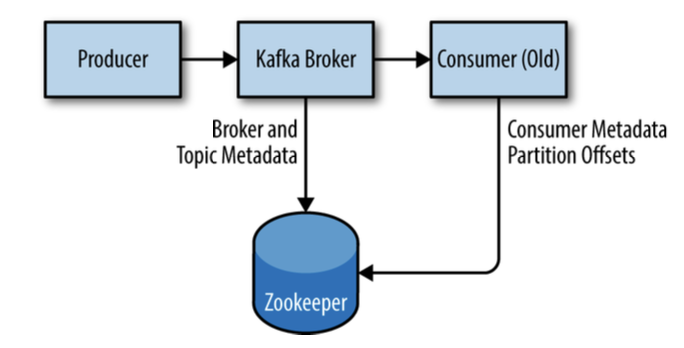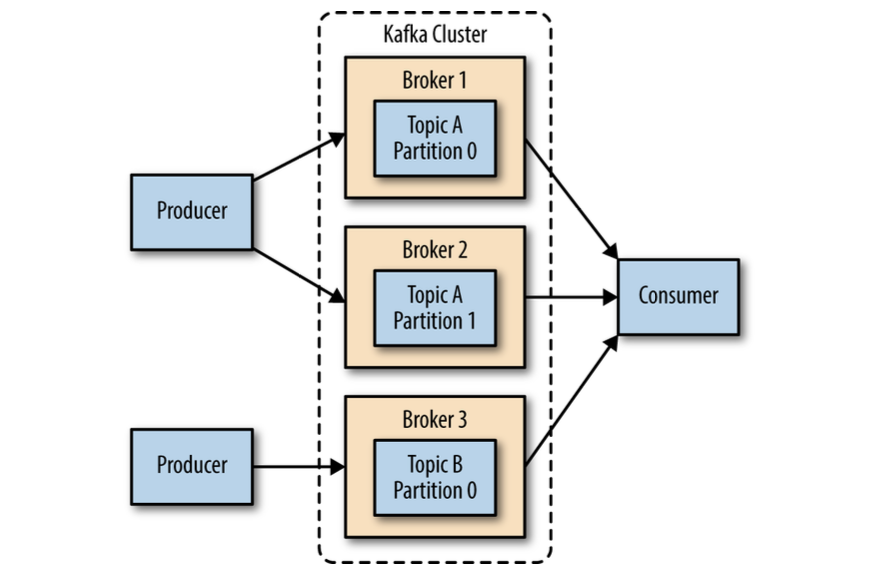Chapter 2
Installing Kafka
Describes how to get started with the Apache Kafka broker, including how to set up Apache Zookeeper, which is used by Kafka for storing metadata for the brokers.
All installations will be done in docker containers, not based on the book.
First Things First
- choosing an OS
Kafka is a Java app, can run on any OS that supports Java.
However, Kafka is most commonly run on Linux.
- installing Java
Kafka requires Java 8 or higher.
- installing Zookeeper
Kafka uses Zookeeper to store metadata about the Kafka cluster, as well as consumer client details.

make kafka
telnet localhost 2181
srvrmake kafka
telnet localhost 2181
srvrZookeeper ensemble
A Zookeeper cluster is called an ensemble. Due to the algorithm used, it is recommended that ensembles contain an odd number of servers as a quorum must be working in order for Zookeeper to respond to requests.
Consider running Zookeeper in a five-node ensemble.
It is also not recommended to run more than seven nodes, as performance can start to degrade due to the nature of the consensus protocol.
Zookeeper config: https://hub.docker.com/r/bitnami/zookeeper
- installing a Kafka Broker
Kafka config: https://hub.docker.com/r/bitnami/kafka
Broker configuration
General Broker
broker.id- unique ID for each brokerport- port to listen onzookeeper.connect- Zookeeper connection string, for storing metadatalog.dirs- list of directories to store log filesnum.recovery.threads.per.data.dir- number of threads to use for log recoverynested with
log.dirs, so it is multiplied by the number of directories specified inlog.dirswhen recovering from unclear shutdowns, Kafka will use this number of threads to recover the log files
auto.create.topics.enable- whether to allow auto-creation of topicsbroker should automatically create a topic when:
- a producer starts sending messages to a topic that does not exist
- a consumer starts consuming messages from a topic that does not exist
- a client requests metadata for a topic that does not exist
Topic Defaults
num.partitions- number of partitions to create for a new topiccan only be increased, not decreased
how to choose the number of partitions:
- what is the expected throughput of the topic?
- what is the maximum throughput when consuming from a single partition?
- what is the maximum throughput when producing to a single partition? (optional)
- if sending messages to partitions based on keys, adding partitions later can be challenging, calculate the throughput based on your expected future usage
- available diskspace and network bandwidth on the broker
- avoid overestimating, as each partition uses memory and other resources on the broker and will increase the time for leader elections.
log.retention.ms- how long to keep messages in the loguse instead of
log.retention.hoursbecause ms has a higher resolution, when will be conflict, ms will winlog.retention.bytes- how much space to use for the logapplied per partition (if you have 3 partitions -> 3x)
log.segment.bytes- how large to make the log segmentsmessages are appended to the current log segment, which can be closed when it reaches the size specified by this configuration and a new segment is created
log segment is a file on disk, so this configuration controls the size of the files on disk
useful when topic have a low produce rate; when fetching offsets, Kafka uses write timestamps to determine which segments to read from.
log.segment.ms- how long to wait before closing a log segmentif the log segment is not full, it will be closed after this amount of time has passed
message.max.bytes- maximum size of a message that can be producedproducer will receive an error if the message is larger than this size
bigger message -> more threads to process it -> more disk reads and writes -> possible less I/O throughput
Hardware Selection
Kafka itself has no strict requirement on a specific hardware configuration, and will run without any issues on any system.
Once performance becomes a concern, however, there are several factors that will contribute to the overall performance: disk throughput and capacity, memory, networking, and CPU.
Disk Throughput
The performance of producer clients will be most directly influenced by the throughput of the broker disk that is used for storing log segments.
Kafka messages must be committed to local storage when they are produced, and most clients will wait until at least one broker has confirmed that messages have been committed before considering to send successful.
This means that faster disk writes will equal lower produce latency.
SSD > HDD.
Disk Capacity
The amount of disk capacity that is needed is determined by how many messages need to be retained at any time.
If the broker is expected to receive 1 TB of traffic each day, with 7 days of retention, then the broker will need a minimum of 7 TB of usable storage for log segments.
You should also factor in at least 10% overhead for other files, in addition to any buffer that you wish to maintain for fluctuations in traffic or growth over time.
Memory
The normal mode of operation for a Kafka consumer is reading from the end of the partitions, where the consumer is caught up and lagging behind the producers very little, if at all.
In this situation, the messages the consumer is reading are optimally stored in the system’s page cache, resulting in faster reads than if the broker has to reread the messages from disk.
Therefore, having more memory available to the system for page cache will improve the performance of consumer clients.
Machine for Kafka only, don't share with others significant services.
Networking
The available network throughput will specify the maximum amount of traffic that Kafka can handle.
This is often the governing factor, combined with disk storage, for cluster sizing.
CPU
Processing power is not as important as disk and memory, but it will affect overall performance of the broker to some extent.
Ideally, clients should compress messages to optimize network and disk usage, Kafka broker will need to decompress messages in order to validate and assign offsets, then recompress the messages before writing them to disk.
Kafka Clusters
A single Kafka server works well for local development work, or proof-of-concept system.

The biggest benefit is the ability to scale the load across multiple servers; second is using replication to guard against data loss due to single system failures (also performing maintenance work on a single broker without downtime).
How Many Brokers?
The appropriate size for a Kafka cluster is determined by several factors:
- how much disk capacity is required for retaining messages and how much storage is available on a single broker
- capacity of the cluster to handle requests (bursts of traffic, etc.)
Broker Configuration
There are only two requirements in the broker configuration to allow multiple Kafka brokers to join a single cluster.
zookeeper.connect- must be the same for all brokersbroker.id- must be unique for each brokerif the same brokers attempt to join the same cluster, the second broker will log an error and fail to start.
- replication configs
OS Tuning
Some changes can be made for Kafka broker that will improve performance.
No notes, because not interesting for me right now.
virtual memory
We can make some adjustments to both how swap space is handled, and to dirty memory pages, to tune it for Kafka’s workload.
disk
networking
kernel is not tuned by default for large, high-speed data transfers
Production Concerns
Before deploying Kafka to production, there are several things to consider.
Garbage Collection Options
Java 7 and the introduction of the Garbage First (or G1) garbage collector.
G1 is designed to automatically adjust to different workloads and provide consistent pause times for garbage collection over the lifetime of the application.
It also handles large heap sizes with ease by segmenting the heap into smaller zones and not collecting over the entire heap in each pause.
There are two configuration options for G1 used to adjust its performance:
MaxGCPauseMillis- maximum amount of time to pause the application for garbage collectionInitiatingHeapOccupancyPercent- percentage of the heap that must be filled before G1 will start a concurrent garbage collection cycle
Datacenter Layout
The best practice is to have each Kafka broker in a cluster installed in a different rack, or at the very least not share single points of failure for infrastructure services such as power and network.
Colocating Applications on Zookeeper
Kafka utilizes Zookeeper for storing metadata information about the brokers, topics, and partitions. Writes to Zookeeper are only performed on changes to the membership of consumer groups or on changes to the Kafka cluster itself.
Recommended that consumers using the latest Kafka libraries use Kafka for committing offsets, removing the dependency on Zookeeper. (offsets can be committed in both)